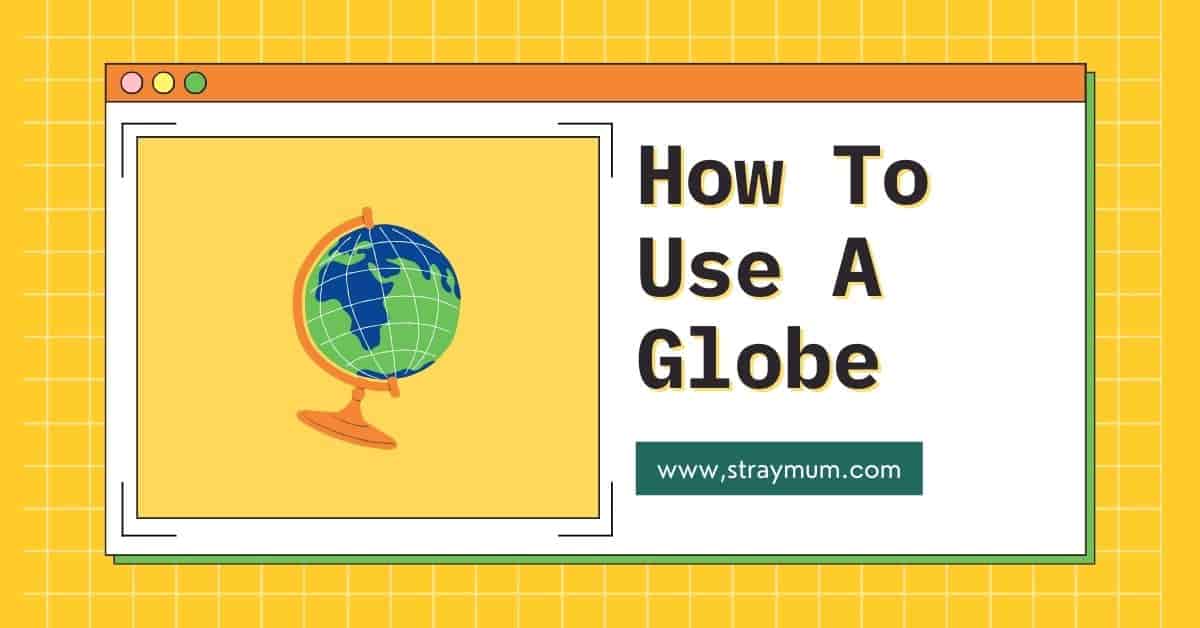How To Use A Globe In Your Homeschool

When introducing kids to maps and globes within your geography lessons it is important to explain to them the difference between the two. Maps are flat drawings of the earth while a globe is a representation of the actual shape of the earth.
How do you use a globe?
On a globe there are two main reference lines from which all distances and locations are calculated. One is the equator, running east and west around the middle of the globe, dividing it into two equal halves. The other is the prime meridian, an imaginary line running from pole to pole and cutting through Greenwich, a section of London, England.
Both of these lines are 0º and the globe numbering system starts at the point where they intersect. All lines running east and west, parallel to the equator, are called latitude lines. They are sometimes referred to as parallels because they are parallel to each other. Latitude lines are shown at 15º intervals north and south of the equator. The lines running north and south from pole to pole are called longitude lines, sometimes referred to as meridians. Longitude lines are numbered along the equator on your globe at 15º intervals east and west of the prime meridian at Greenwich.
What Country is at 0 Degrees Latitude and 0 Degrees Longitude
This location is in the tropical waters of the eastern Atlantic Ocean, in an area called the Gulf of Guinea.
Which Way Does The Globe Rotate?
When viewed above the North Pole, the Earth rotates counterclockwise, from west to east. This is also called a prograde rotation.
The International Date Line
Get your kids to look at your globe and find the international date line along the 180º meridian in the Pacific Ocean. It is halfway around the world from Greenwich. This means that when it is noon in Greenwich, it is midnight on the International date line, and it is on the International Date Line that a new day is born. As you travel 15º east or west of Greenwich you would gain or lose an hour and if you travelled completely around the world you would gain or lose a complete day.
The international date line is the place internationally agreed upon at which the loss or gain of a day takes place.
Ask your kids what they notice about the International Date Line. Hopefully they will notice that there are a few movements in the date line. In order that the eastern tip of Siberia has the same date as the rest of Russia and the Aleutian Islands has the same date as Alaska, the date line moves away from the 180º meridian to avoid these points.
Miles in Degrees
The length of a single degree of latitude on Earth’s surface is about 69 miles, and is fairly constant because lines of latitude are all parallel and equally distant. However it is different with longitude lines, as they gradually move towards the same point and become closer together at the poles. One degree of longitude at the equator equals 69.17 miles, but as you move toward the poles, the distance between longitude lines diminishes. At 40º latitude, a degree of longitude equals 53 miles, at 60º the length of a degree of longitude is about 35 miles and at 90º, where all lines meet, at the poles, it is 0 miles.
Why should the Globe be used for the study of the world?
A basic use of a globe is to simply be able to find places such as bodies of water and countries. However with a globe we are able to see its true geographical relationship with the rest of the world. We are easily able to see which countries border each other and the distances and directions between locations. A globe is the only accurate way to study the whole Earth as it is not distorted like a flat map.
Ideas For Ways to Use a Globe in Your Homeschool
Literature
When you are reading a book use a globe to locate different countries that are mentioned within the book. Find out what the latitude and longitude of that country are and if it is a different country to where you live you could find the latitude and longitude of your country.
Spin and Point
Spin the globe and then get your child to blindly point at a country or body of water. Then find out about that country or body of water. This can lead to great projects that can include finding out about particular clothing that is worn, what is the national food dish of the country (you could even try making it), what is the population, what is the temperature like, the things your kids could look for is huge. We have had great fun and learnt a lot about different cultures using our globe this way.
Why Do We Need Globes For Kids?
Globes are very tactile and kids can be very hands on when using globes. They help kids to be able to see and visualise the size of countries and continents and where they are in relation to each other.
They are a great way to teach about latitude and longitude as although these are imaginary lines they are on a globe as though they actually exist.
They spark a natural curiosity in kids because of the hands on nature of globes and they usually want to find different countries that they have either visited or heard about and where they are in relationship to where they live./
Teaching with globes is a wonderful way to get your kids learning about the world as they provide a wealth of knowledge. I hope that this has given you some ideas to start using your globe within your homeschool.

